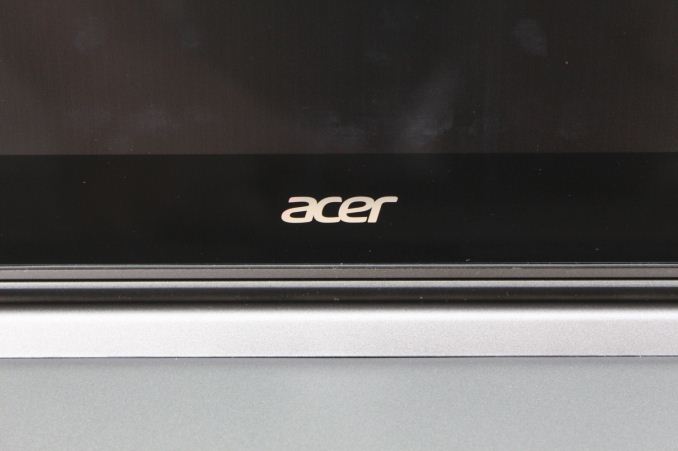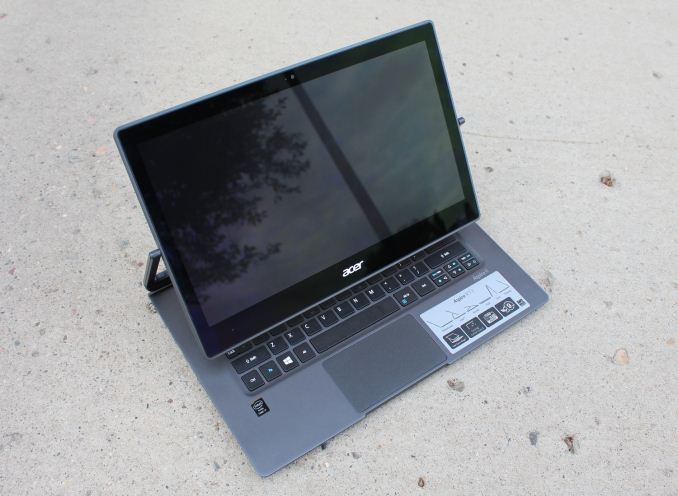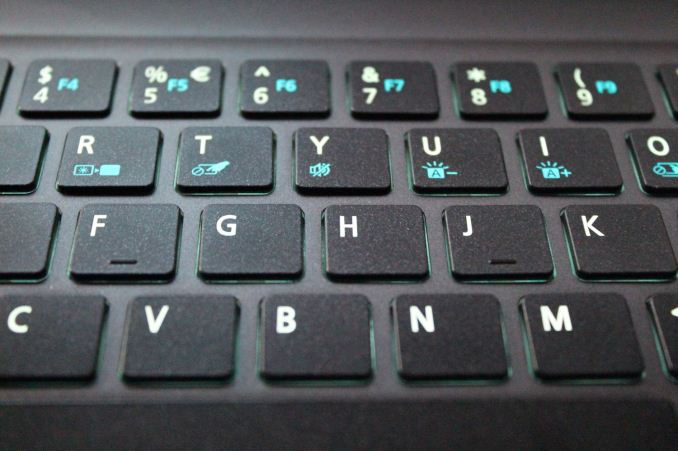The Acer Aspire R 13 Review: Convertible Notebook With A Twist
by Brett Howse on June 15, 2015 8:00 AM EST- Posted in
- Laptops
- Acer
- Aspire
- Ultrabook
- Broadwell-U
- Aspire R 13
Final Words
The Ultrabook was launched in 2011 by Intel, and the form factor has gotten much better over the years due to the improved efficiency, thermals, and performance of the processors. The 13.3-inch category is very popular. The rise of convertibles has given people more flexibility in how they do their computing and it has been fun to watch the different designs over the years, which have been whittled down to two basic forms. A tablet which docks to a keyboard, and a notebook where the keyboard can fold under the display. Acer has taken a different road here with their U-Frame and it opens up a couple of extra modes in which the Aspire R 13 can operate in.
Any time a company bucks the trend and tries something new, it is certainly worth taking a look at. That does not always mean that the different design is going to be more beneficial though. The U-Frame hinge certainly has some advantages. It is very robust and makes for an overall better touch experience due to the display being mounted midway up its height. This helps a lot with bounce and deflection when compared to other touch screen Ultrabooks. I am also a big fan of Acer’s dual-torque hinge which makes it very easy to open the notebook, but stiffens up at 90° in order to allow you to use it with touch.
The two new modes that the U-Frame hinge brings are the “Ezel” mode and “Stand” mode. The stand mode is certainly the more useful of the two, and fits in well with the use of the active pen that Acer offers as an option for this device. It is very easy to put the device in stand mode and take notes with it. It is very similar to the Surface line in this regard.
I don’t think that either of these modes overcome the downsides of the U-Frame hinge though. Having to rotate the display inside the frame is a more intricate task than just flipping the display under like most convertible notebooks. Also, since the touch keyboard will not operate in either of these two unique modes, it really makes it hard to use either of them. It is a pretty important thing to be able to use the keyboard, and in both of these scenarios the physical keyboard is unusable. This is a major flaw and it is difficult to understand how this happened. There seems to be a hardware switch which kicks in and enables the touch keyboard when the device is flipped all the way into a tablet, or used in display mode, so it just appears to be an oversight by Acer that this hardware switch does not kick in sooner.
As a notebook, it is not particularly impressive either, with the extra width and mass of the U-Frame not doing it any favors. It is far from big or heavy, but there have been some very impressive devices launched this year to compare it against. Although the Gorilla Glass on the top cover is a nice effect, the rest of the device is hard touch plastic and lacks a wow factor. The keyboard is quite a ways off the leaders in this area, and the trackpad is also plastic, with competing devices at this price point often having glass trackpads which offer a smoother experience.
On a pure notebook, the more limited viewing angles of the PVA panel would not bother me as much, but we have become accustomed to tablets having great viewing angles. This same panel is, from what I can find, the same offered on the Acer S7, and in that device it would be fine. On this device though I found it to be a distraction.
Battery life is good, but not class leading. Most people should be happy with the battery life offered in this notebook, but considering it is larger and heavier that much of its competition, it is really too bad that a larger battery was not used, since the actual device efficiency is quite good.
In the end, I walk away from the Acer Aspire R 13 with the feeling that Acer is trying something new here, but it is not working as well as they had hoped. The design is certainly unique, but the drawbacks overshadow the small gains available. If the R 13 was a more budget offering, some of this could be written off to cost savings, but in the end the Aspire R 13 is not a budget convertible. The MSRP of the i5 model is $900 with a 128 GB SSD, and the i7 is $1300 with the higher resolution display and a 256 GB SSD. The top 512 GB model is $1500. Once you get to those prices there are some very good machines you are competing against, and in this instance it seems Acer has fallen short of the mark.













25 Comments
View All Comments
Shadowmaster625 - Monday, June 15, 2015 - link
"Tent mode is also very useful, either when in cramped conditions such as in an airplane, or when you have a tablet to set the device on and want to use it in touch mode"Why would you want to set one tablet onto another tablet?
RT81 - Monday, June 15, 2015 - link
Pretty sure he meant table.der - Monday, June 15, 2015 - link
Good to be third!der - Monday, June 15, 2015 - link
Btw you guys from anandtech should leave a link to download those ICC profiles you calibrated. Really helps!damianrobertjones - Monday, June 15, 2015 - link
"What makes the Aspire R 13 somewhat unique "As you suggested it's not really unique. Dell was, as far as I recall, the first to feature a machine like this with their Dell Inspiron Duo. Not a bad machine.
azuun - Monday, June 15, 2015 - link
Pretty sure the first machine like this was the Vadem Clio https://en.wikipedia.org/wiki/Vadem_ClioThis was actually a pretty cool little device for taking notes at school, at the time, since most laptops back then were several pounds heavier and more expensive.
damianrobertjones - Monday, June 15, 2015 - link
We have a WINNER! You cannot dispute the link. Well done that man.Vihaan Kulkarni - Tuesday, April 7, 2020 - link
This device could really be helpful with it being so light and not bulky. However, the price does seem a little steep. Also, the unique point is not really true, I think. Dell, did have something similar launched way before this product.creed3020 - Monday, June 15, 2015 - link
I would still take the Lenovo Yoga Pro 3 over this device. The pricing is more competitive from Lenovo, and getting a 512GB SSD in the Yoga Pro 3 isn't going to cost you a body part.kaidenshi - Monday, June 15, 2015 - link
I get where you're coming from, but I won't touch another Lenovo after their malware/poisoned cert fiasco. Too bad no one else has stepped up to make a really great Yoga Pro competitor.